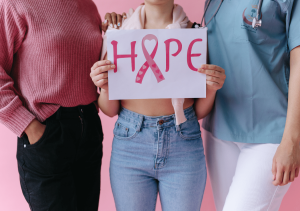Table of Contents
Breast Self-Exam
Breast Self-Exam
Breast self-exam (or regularly inspecting your breasts by yourself) can help you detect breast cancer earlier, so it can be treated more effectively.
Breast self-exam is a way to detect breast cancer early and to have it treated quickly. While no single test is able to detect all breast cancers, there are many ways that a breast self examination can help increase your chances of finding them early.


There has been much debate over the value of breast self-examination in early detection and survival rates. A 2008 study of almost 400,000 women from Russia and China found that breast self-examination has no meaningful impact on breast cancer survival rates. It may even be harmful by prompting the unnecessary removal of suspicious tissue (biopsies) and causing harm. The American Cancer Society has stopped recommending breast self examination as a screening tool for women at average risk of developing breast cancer.
Breastcancer.org recognizes that breast self-examination is a valuable and important screening tool. This is especially true when it’s combined with:
- Regular physical examinations by a doctor
- mammography
- Ultrasound, MRI (magnetic radiation imaging), or both
Regular physical examinations by a doctor
mammography
Ultrasound, MRI (magnetic radiation imaging), or both
Each screening tool works in a different manner and each has its strengths and weaknesses. You can perform a breast self-exam at no cost on a monthly basis. It is also a great tool to use as part of your overall screening strategy for breast cancer.


How to perform a breast self-exam at home: Five steps
How to perform a breast self-exam at home: Five steps
Step 1: With your hands on your hips, examine your breasts with a mirror.
Step 1: With your hands on your hips, examine your breasts with a mirror.
Start by looking in the mirror at your breasts with your shoulders straightening and your arms crossed.
- Here are some things to look out for:
- Breasts that are the same size, shape, or color as their normal size.
- Breasts that are perfectly shaped, without visible swelling or distortion.
- You should inform your doctor if you notice any of these changes.
- Skin bulging, puckering or dimpling
- A nipple inverted (pushed inward rather than sticking out), or a nipple in a different position
- Redness, soreness or rash.
Step 2: Check for signs of breast fluid
Step 2: Check for signs of breast fluid
While you are looking in the mirror, check for fluids coming out of either one or both of your nipples. This could be watery, yellow, or milky fluid, or even blood.
Step 3: Lift your arms and examine your breasts
Step 3: Lift your arms and examine your breasts
Now raise your arms and search for the same changes.
Step 4: Feel for breast lumps while lying down
Step 4: Feel for breast lumps while lying down
Next, feel your breasts by lying down and feeling them. Use your right hand for your left breast and your left hand for your right breast. Keep your fingers flat and tightly together by using a firm, smooth touch on the first few finger pads. Use your fingertips to press down on your fingers, and then move in a circular motion about the same size as a quarter of an inch.
You should cover your entire breast, from top to bottom, from side to side, from your collarbone to the top, and your armpit to the top, with your cleavage.


To ensure that your breasts are covered, follow a pattern. Start at the nipple and work your way up to the outer edges of the breast. As if you were mowing the lawn, your fingers can be moved vertically. For most women, this up-and-down method seems to be the best. You should feel the entire tissue of your breasts from the front to your back. For the skin and tissue below, apply light pressure. Medium pressure is used for the tissue in your middle; firm pressure is used for the deeper tissue. Once you feel into the deep tissue, your ribs should be visible.
Step 5: Check your breasts while standing or sitting to feel for lumps
Step 5: Check your breasts while standing or sitting to feel for lumps
Feel your breasts whether you’re standing or sitting. Women often find it easier to feel their breasts when the skin is slippery and wet. This is why they prefer to take this step to the shower. Use the same hand movements as step 4 to cover your breasts.
What to do if there is a breast lump
What to do if there is a breast lump
If you feel a lump in the breast, don’t panic. Many women feel lumps in their breasts, but most of them are benign and not cancerous. Breast lumps that are not cancerous can be caused by normal hormonal changes, benign breast conditions, or injuries.
If you notice a new or unusual breast condition, don’t hesitate calling your doctor. This is especially true if the changes last longer than one menstrual cycle, or if they become more obvious or larger. You may wait until your period to check if your lump or other breast changes disappear on their own before calling your doctor. Your best healthcare provider is one who knows you well and has performed a breast examination on you before. This could be your primary care doctor or your gynecologist.
What to expect? Your doctor will take a history, examine the breasts, and then order breast imaging tests. If a woman is younger than 30, or pregnant, or breastfeeding, an ultrasound is the most commonly used imaging test to assess a lump. An ultrasound and a mammogram can be used to examine a lump in older women, if they are not pregnant or nursing. Your doctor may recommend further imaging such as MRI, MBI, biopsy or any combination thereof if additional testing is required. For further evaluation, your doctor may refer you to a specialist in breast surgery (typically a breast surgeon).
You should always get the answers you need. Your doctor should explain the cause of your lumps or other breast changes. If necessary, they will also develop a treatment plan. Don’t be afraid to ask for a second opinion if you aren’t satisfied with the doctor’s recommendations.


How to include breast self-exam in your breast cancer screening strategy
How to include breast self-exam in your breast cancer screening strategy
It’s important to make it a routine. You will learn more about your breasts and be able to spot any changes. To get a better understanding of how your breasts look and feel, you should do a breast self-examination at least once per month. When your breasts are most tender and swollen, you can examine yourself after your period has ended. You can choose to stop having periods if you don’t have them anymore.
Learn about the different areas of your breasts. The outer, near-armpit area tends to have the largest bumps and lumps. You may feel the lower half of your breasts as if it were a pebbly or sandy beach. You might feel the area below your nipple like a bunch of large grains. A different part may feel like a bowl full of oatmeal.
Keep a journal in which you can record your findings from breast self-exams. You can use this journal to create a map of your breasts and make notes about any irregularities or lumps. The journal can help you to remember what normal is for your breasts, especially in the beginning. If you’re still having menstrual cycles, it is common for lumps to appear in certain months and disappear later.
